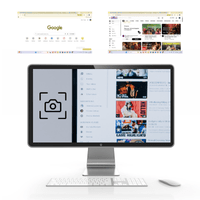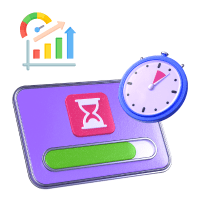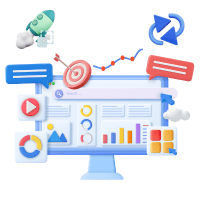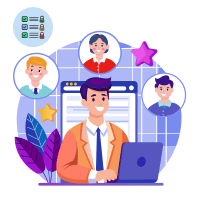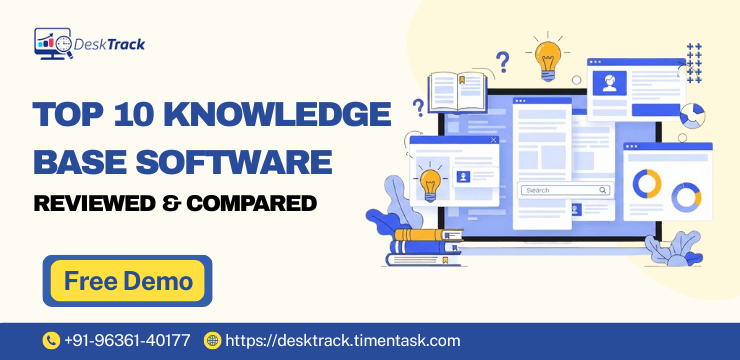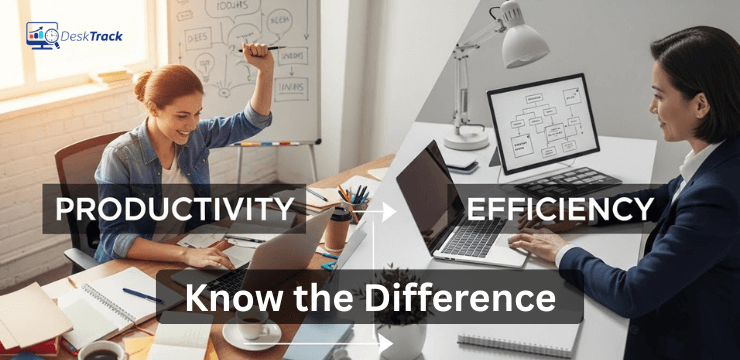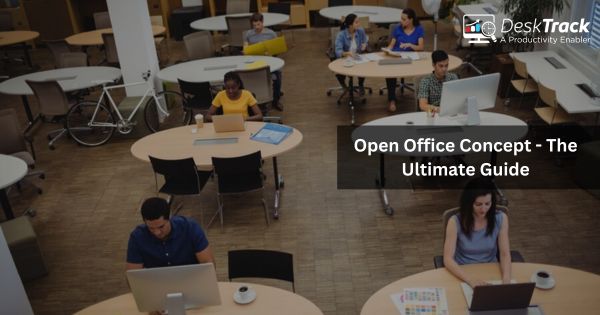
Have you ever thought that there is a direct relation between productivity & architecture of your office? And this relation is scientific. I am obviously not speaking from the perspective of ‘vastu-shastra’.
Basically, back in the 1900s people used to work within an open-office concept, where there is no division of internal wall, cubicles, or any such setup which makes an employee ‘alone’. Such a setup was discovered keeping the productivity of employees in mind.
Now here are some basic questions that can arise in your mind:
- How does an open office look like?
- How exactly it help to boost employees’ productivity in the workspace?
- Except advantages, what are the disadvantages of the open office concept?
Definition – The Open Office Concept
The open office concept is an idea of pulling down both physical & metaphorical walls in an office. Such a setup lets employees communicate & collaborate on tasks and projects, more openly & effectively.
The open-space platform can take up 3 types of form, based on the needs of the company and the type of work:
- Fully open offices
- Half-open offices, and
- Team-structured offices
Fully-open Offices
As the name suggests, fully-open offices are designed in a large space with no walls, merely categorizing workers, teams and departments. Fully-open office set up for companies that deal in the creative field, or require constant collaboration in the course of the task.
Besides, other departments that make use of the open-office layout are:
- Software development,
- Sales,
- Project management,
- Research,
- Media,
- Consulting services, and others.
Half-open Offices
Such setup is a combination of ‘collaboration space’ and ‘focus space’, provided as per the need of the employees and teams. Offices in such a setup include partitions that though have open spaces but also include one to two meeting rooms for ‘focus’ time.
Team-structured Offices
Team-structured offices, though possess open spaces for work, but here is a team/departmental wise physical segmentation of space.
For example – IT team sits in an area where the developers work together, whereas HR has a separate cabin for conducting his meetings.
Advantages of Open-plan Office
Besides, improved productivity and efficiency, below are mentioned some major advantages of open-plan offices:
- Creativity
- Better Health
- Advancement of company culture
How are employees’ health benefitted?
As per research published in BMJ Journals “Open bench seating may be an unrecognized positive factor in promoting physical activity levels at work.”
Open-bench seating employees are 32% more active, than the employees in a private office.
Open-office employees are 20% more physically active than employees working in cubicles.
Jennifer Veitch, Ph.D. in her research paper on workplace mental health mentioned that high-density offices possess increased psychosocial work stressors. Also, it has more cognitive issues, such as decreased working ability, with reduced environmental satisfaction.
Additionally, Jennifer claims that the surrounding environment of work is very important for preserving mental health. And the environment includes the light, interaction with colleagues, & open space.
How can you boost creativity in an open-plan office?
Needless to say, open floor plans prove to be a perfect setup for teams to communicate and exchange ideas.
For a frequent brainstorming session, such space proves to be a boon. The industries that absolutely benefitted from this plan are:
- Content marketing & social media
- Software development
- News Industries
- Graphic design
- Contact centers
Make Your Workday More Productive
Time tracking and work management can help you reach your goals faster.
Try 15 Days for Free

How does the open office concept contribute to advancement in company culture?
Setting a common workspace out rightly pulls down the hierarchical work setup in a company. It sends a message that all employees are equal and have equal rights.
Moreover, seniors are easily approachable. This enhances the collaboration of employees in their leadership. As per a study, it is 6 times easier for colleagues to interact with each other when they are on the same floor.
As every coin has two sides of it, let’s explore the other side of open-plan office – the disadvantages.
Disadvantages of Open Office Concept
Some of the uncalled disadvantages of this type of office setup are as follows:
- Noisy environment
- Inability to do face-to-face interactions
- Decreased concentration
Noisy environment
The fact that deep work and deep focus are important can’t be denied & ignored.
As Cal Newport says “ Activities performed in a state of distraction-free concentration that push your cognitive capabilities to their limit.”
Moreover, allegedly 93% of workers feel distracted due to noise & other general interaction.
Additionally, author of the book How to be Heard and Sound Business claims noise to be a major concern in open workspaces.
Inability to do face-to-face interactions
As per research on The impact of the ‘open’ workspace on human collaboration, face-to-face interactions have gone down by approx. 70%. The reason for the latter is that in an open space, people avoid disturbing their colleagues around by speaking loudly.
In the open office concept, the electronic interactions have gone up from 20% to 50%.
Decreased concentration
Allegedly, working in an open space has proved to cause suffocation & less satisfaction to employees, leading to decreased concentration & hence less productivity.
Moreover, the ambience of open office tends to affect transparency from employees too. As per a statistics, 31% of employees feel uncomfortable expressing their opinions, while having calls in the office. They don’t want their colleagues to overhear the conversation.
How do You Ensure Productivity in an Open-plan Office?
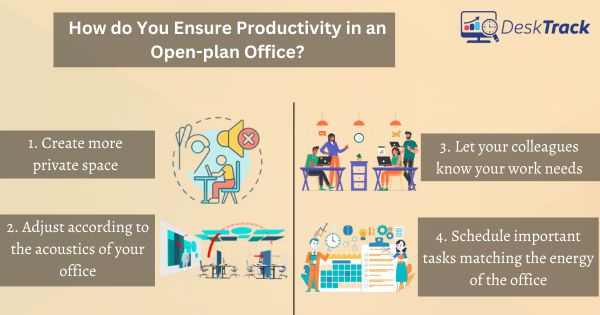
Nonetheless, even if the open-plan office has some disadvantages, because ultimately there are ways through which you can achieve concentration, productivity, you name it all, altogether.
1. Create more private space
Time management & efficiency expert Alexis Haselberger suggests employers to make their space more comfortable & ‘ready-to-focus’ zone.
“Create lots of ‘private’ nooks using furniture spacing (think: a comfy chair in a corner). Provide noise-canceling headphones so that employees are less distracted by the conversations of others.”
Further, she suggests creating ‘quiet areas’.
“Just like the quiet car of a train, designate quiet areas of the office. Install ‘phone booths’ with sound protection so that people on calls aren’t bothering everyone else.”
Moreover, she suggests creating enough conference rooms to avoid meetings in the open space.
Additionally, she has also recommended working from home as an option, for the sake of increasing productivity.
2. Adjust according to the acoustics of your office
A 5x TED speaker, Julian Treasure has emphasized the importance of sound and well-being & productivity of employees.
He has come up with a method of dealing with sound in the working atmosphere. It is abbreviated as MBA.
M — Move and find a quiet place where you can concentrate,
B — Block, which involves using headphones (preferably noise-isolating headphones), and
A — Accept working in a noisy environment.
Additionally, Julian suggests creating biophilic soundscapes, which can bring the health-giving, refreshing sounds of nature into the workspace.
3. Let your colleagues know your work needs
Julia Arndt, a stress management trainer suggests making your workstation more personal. He says “Create a safe space — bring plants, pictures of your loved ones, maybe another lamp to make you feel comfortable in your own space.”
She also emphasizes on the value of communication to make open space worth working with great focus. She says “Set clear boundaries by communicating what you need — some people might just wear headphones to be “left alone” from in-between chats and others might look to book a conference room to work quietly. Also, have an open conversation during a team meeting on what everyone needs to be more productive.”
4. Schedule important tasks matching the energy of the office
Kristin O’ Donovan, a productivity coach suggests planning out your tasks, matching the energy of the office. For example, it’s a completely failed idea to do your most important task between 9-10 am, as the office energy is filled with the coffee-break vibe.
Therefore, plan your time & tasks, matching the energy of the office, wherever possible.
Moreover, she adds for creating visual barriers to your workspace. She states “Protect your space by creating some division where possible, even visually, to prevent your eye from catching so much movement, use a Do not Disturb sign to prevent interruptions.”
Open-plan vs Closed Office. What’s the Better Choice?
There cannot be one absolute option to choose between the two. Every option has certain pros & cons to suffer. Therefore, to make the right decision, you can consider the below-mentioned factors:
- Business needs
- Organizational culture
- Employee preferences
Business needs
There are businesses that cannot operate without teamwork. Also, there are modern offices that require teams to attend:
- Meetings,
- Seminars, and
- Workshops
Therefore, the number of employees in an office also decides the office layout. Taking into account an office with 200 employees cannot function in open space, due to noise & distractions.
Besides, the type of work conducted in a business also determines the office layout. Taking into account an IT firm, an office with closed cubicles would suit the best, as developers require more focus on the task at hand.
Organizational culture
Organizational culture is nothing but a set of beliefs & standards, followed by a company. Such beliefs and standards are reflected in its employees too.
Some companies prefer grind & individual culture, for which a closed cubicle office proves to be a solution.
On the other hand, for companies that prefer “all for one, one for all”, I think open-office is a go-to solution.
Employee preferences
In the end, it’s the employees who have to derive results. Therefore, seeking their opinion would always matter. Needless to say, there are employees who are extrovert & can perform well in open-space workstations. On the other hand, there are introverted employees who prefer to accomplish their tasks in a closed space, with more focus and less distraction.
Therefore, to deal with the best in such a situation, HR should conduct meetings and seek their opinion and ways to enhance productivity.
Learn how DeskTrack is the Right Choice for Tracking Attendance & Productivity for Your Employees.
No matter what your choices are regarding the office layout. But it is always important to track the productivity delivered by your employees. Well, on that note DeskTrack has got you covered. Its numerous features ensure to not only track productivity but also attendance of your employees. Below are mentioned its features to consider:
- Time tracking
- Application & URL tracking
- Project time tracking
- Measure employee engagement
- Manage productivity
Note: To learn more on ways to increase employee productivity, visit 5 tips to improve employee productivity in 2024.

